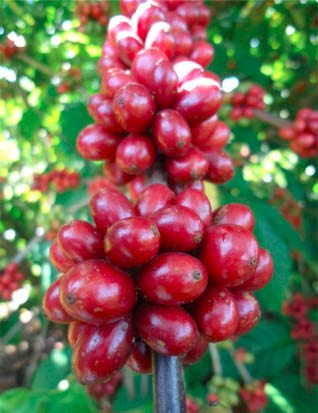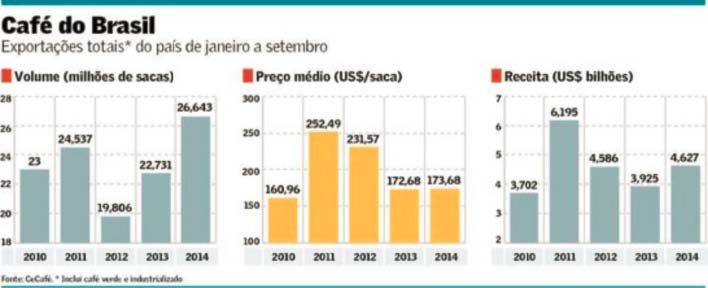Rabobank estimates that coffee production in 2015 under the best case in Brazil up to 47 million bags. Even the coffee-producing areas in need of rainfall are abundant within the next few weeks, the yield for the coming year and in 2014 only flat. However, if there is no rain, or as a world leader in coffee production in Brazil is facing other problems, then the coffee production in the coming year will be reduced.
September this year due to fluctuations in the price of coffee trading temporarily lead after ICE coffee futures prices higher and Brazilian currency (Lille) devaluation brought to market more years 2015/16 and 2016/17 delivery orders. Which deal in southern Minas region, 塞拉多米内罗 and Bahia region more orders. The current trading volume of coffee production reached in 2014 estimated 4,890 million bags of 54%, ie 2,664 million bags.
A significant increase in coffee exports
While there is a period of price volatility, but in Brazil in January 2014 to September of coffee exports still made remarkable achievements, reached a total of 26.6 million bags, an increase of 17.2 percent in 2013, an increase of 4 million bags. This nine-month total exports, the Robusta accounts for 2.2 million bags last year an increase of 117% period. Cecafé estimates that by the end of 2014, Brazil's coffee exports will reach between 34 to 35 million bags.
Espirito Santo boutique coffee $ 105 million investment
Coffee supply chain leader and Espirito Santo Development Bank (BANDES) in October this year held talks to discuss the bank in July 2014 to develop the state's next planned project of specialty coffee. As of 2015, the project to all coffee growers have access to technical support provided by the Brazilian Small Business Promotion Agency (SEBRAE). The next four years, the state bank (BANDES) will provide $ 105 million in available funds at all stages of the coffee production chain, and plans to support growers and 2,500 were 500,000 bags of coffee certification. The purpose of the implementation of this program is to encourage sustainable coffee production, expanding the number of Espirito Santo roasters supply of high-quality roasted beans and roasted flour.
100th Session of excellence Cup race
Brazil 100th Session of excellence Cup awards ceremony was held in October, revealed 21 of 85 points or more in value of the honey processed coffee. Champion models scored 94.05 points, produced in the Bahia region Piata municipalities Ouro Verde estate. 2,3,4 were also scored 90 points or more, from the same city in Brazil. 21 of coffee before the contest will participate in the November 26 online auction. Coincidentally, the first one in Brazil and 100 Grand Prix Cup of excellence have become part of the national-level Coffee Organization (ICO) activities. Confined to the territory of Brazil started organizing this contest, the first auction is in Brazil, after many years has been introduced to other countries.
The world's first coffee harvester 35 anniversary
This is a project ahead of its time. It is 35 years ago launched the first station on behalf of a coffee harvester, and coffee-producing areas was no demand for it now so obvious. This machine is Campinas Institute of Agriculture, the result of cooperation between the Institute of Brazilian coffee has disappeared and equipment manufacturing company in Brazil visionary. Due to the lack of labor force continued to increase their costs, have been hand picked by Brazil (now the world) coffee production expansion constraints. Since then, mechanized harvesting on the expansion of coffee production in Brazil has made tremendous contributions. P inhalense P1000 recently introduced self-drive mechanical harvester has many innovative features, including the ability to respond to other harvester on the market today can not pass the steepest slope.
Uncover new varieties of coffee and an exotic
Campinas Institute of Agriculture has determined that it has developed the exotic nature of a coffee flavor, such as fragrant eucalyptus, rosemary and mint. The coffee flavor is obtained from commercial varieties and hybrids of wild varieties of the Institute after the gene pool. The Institute is now part of the cultivation of coffee seedlings, fruit trees to detect whether the target will contain these features. This study will also monitor the overall quality of the coffee produced.

EMPRAPA first registered in Rondonia Connie Long cultivars
Developed by the Brazilian Agricultural Research Institute of BRS Ouro Preto in Rondonia region registered cultivars. This is the first national variety protection certificates for protection agencies Coney dragon species. The BRS Ouro Preto varieties originated from research that began in 2012, and after adaptation to climate and soil Rondonia coffee trees after carefully screened before finally obtained. It's recommended planting area is dry areas or areas require irrigation. After a full farming potential yield that can be achieved BRS Ouro Preto is: non-irrigated area 70 bags / ha (280kg / acre); Irrigation District 100 bags / ha (400kg / acre). This results in the recent drought, the majority of small farmers and growers in the region, the lack of technology is undoubtedly very excellent.
37th National Coffee Cultural Festival
Pinhalense and P & A is located in Espirito Santo - Pinhal held the 37 circles including conferences and trade fairs coffee culture festival. Cultural festival, the famous coffee companies and research institutes, including Nespresso, FMC, BM & F, Sebrae, Sao Paulo State University (UNESP), Hanns R.Neumann Foundation reports show a wonderful program, but also shows the mechanical harvester equipment . Workshop on recurring topic is climate change and the future prospects of the Brazilian coffee crop. Yield losses in 2014 and 2015 is positive, but the reason they come from different aspects, namely, the poor early growth of coffee beans, the small number of fruiting late.
Climate change, and the main differences between production in Brazil: a layman's point of view
Brazilian coffee practitioners have never had such a high demand for meteorologists opinions, obviously, I am also one of the staff in these information requirements. I have heard from so many different sources of information in here that I ventured to give me a layman's conclusion, hoping to cause further discussion.
My main difference from the 2014 and 2015 general direction of yield loss began to reason, in 2013 coffee trees blossom normal or even good, which makes the initial stages of the formation of the number of fruit caused a very good harvest is expected this year. However, the drought in the first quarter of 2014 is expected to lead to frustration, because not fully grown fruit, beans and bear to be smaller than in previous years, to light, even in some irrigated areas, but also because of the high temperatures lead to defective beans and black beans lack of rainfall also limits those now flowering and growth in 2015 is about the results of the coffee tree. Assuming normal rainfall from now and flowers are grown plump fruit, it can be said that 2015 production will be lower than average, due to the growth of the smaller branches last year, less the amount of fruit, that is, no coffee trees can be bred to grow enough fruit branches, the length of the branches is not enough, or is capable of flowering branches and nodes inadequate results. In some places did occur when there is not enough rain to keep the flowers bloom to form fruit, resulting in a further decrease in the yield. Recent rains during flowering may make up for these losses, but rain did not cover all of the coffee-producing areas.
In short, the drought in 2014 led to a lot of fruit can not bear full of coffee beans, but also lead to reduced fruit production in 2015. Whether the loss is limited to 2015 can grow into a smaller number of fresh fruit full of coffee beans, coffee beans or poor quality due to the growth and lead to further losses - depending on weather months, especially in 2015 on the future climate in the first quarter, a decrease is certain. So, how future climate predictions a few months it?
For 2014 years what happened a number of theories, many years will occur once the pattern has not been repeated from one amazing fact to every, even including another frequency to determine the mode of occurrence yet. Recent weather forecasts suggest that rainfall coming in January to March will not be the same, but less than the average of 2014 and. Reference to past records found similar rainfall patterns, the next 5-7 years may be below average rainfall, but the gap will gradually narrow, reaching an average rainfall.
What can we expect in 2015? If the rainfall and temperature returned to normal, then the coffee production in 2014 and will be the same, or slightly lower, due to the loss due to the insufficient number of branches and flowers and produce. But if rainfall is less, and / or temperatures above average, so in 2015 the production will be lower than in 2014, as to how many will be low, and that depends on the severity of climate.
Those who advocate 2015 production will be substantially higher than 2014 staff ignored the potential production in 2015 has been affected by the reasons mentioned above, namely, lack of basic length of the branches, flowering less than usual, they are now just by the situation is considered a potential production will be higher or much higher than expected yields. It is this extreme differences often resulted in estimates of the value of the above factors and anticipate the same loss, but a huge difference separating differences can sometimes great potential yield between estimated value. This may explain the differences in a long list of estimated production Brazilian government and business, USDA made between. Who is yet to be determined, but this time we believe that the market seems to be setting an upper limit does not exist.
Recognized worldwide, large and small plants are suitable for coffee beans processing line shell leader --Pinhalense
With production Pinhalense export coffee processing equipment can growing trend, a number of production Pinhalense supply has reached 28-42 tons / hour Arabica and 28-36 tons / hour of Robusta production line has clearly laid its leadership position. These plants can be processed in two shifts every day 10,000 bags of 60kg / bag of coffee, or four million bags of coffee per year can be processed, while leaving out plenty of downtime can also increase the group, and then increase to 50% of capacity. Alabie bean processing line stuck in any one of these can be processed finished the year in Mexico or Guatemala Arabica; while Robusta plant any one is able to process in Uganda or India finished the year Robbs tower. These data allow us surprised - these two types of coffee processing production line may be the world's largest production capacity of their equipment - they represent those who appeared in the past 10 years, the current decade, the equipment requirements for increasing capacity, speed continuation of the trend of faster and faster.
Pinhalense been declared: the coffee plant's success also depends on device performance and process efficiency. When the production capacity to 12 tons of Arabica plants / h above or Robusta production and energy 14 tons / hour and above, depending on the efficiency of the process will become more important. In these capacity or greater capacity processing plant, not to emphasize the processing capacity of a single device, so customers only rely on themselves to improve or expand an existing small craft production line approach to the design of new plants it is no sense, because this would hinder their access to a variety of benefits from Pinhalense extraordinary scale coffee processing plant design capabilities.
Pinhalense computer-aided design (CAD) facilities created so that all customers can benefit from a permanent improvement of environmental design. No matter the size of plants, exporters or multinational traders how much opportunity just from its internal engineers and technicians have designed some of the coffee plants, because their main contribution to the operation and maintenance of the plant rather than design. These have been designed with more than 19,000 coffee plants, and in the past two years, an average of more than one record is plant design compared to the amount Pinhalense day. This is a reliable technical indicators, and the transfer of these technologies are available for free to customers who purchased the Pinhalense the entire process of production lines.
A complete project includes (a top view and a partial cross-sectional view of the bottom /) equipment layout, process flow diagrams, the minimum size, and civil engineering construction diagram (plant LWH), equipment, infrastructure diagram (including the upgrading of wells, platforms, etc. ), location map of the motor as well as other supporting drawings. We can also provide factory layout according to customer requirements. Although the contents of a set of design drawings are the same regardless of project size and plant capacity size, but large projects have their own requirements.
Small projects can easily solve the problem size increases when the plant will be magnified, such as coffee reception, change product categories to be processed, the coffee sub (ordinary bags, big bags or bulk), dust treatment, and disposal disposition thereof. This is why some of the reasons Pinhalense development of small projects, such as high capacity, low friction, self-cleaning hoist is used to solve some of its features coffee injury, improve bottom cleaning machine downtime, ordinary bags - big bags - in bulk interface, and bulk handling products and waste issues. After the customer has purchased a full Pinhalense equipment, in addition to enjoy technology and efficiency gains, but also to get to the other tangible benefits, such as equipment performance and protect its agents around the world Pinhalense exclusive, repairs and accessories services. This has a significant impact on earnings, taking into account any of the coffee plants, especially large plants have a very tight contractual arrangements.
Because medium-sized plants and processing capacity production line raises a new problem: how to process small quantities and micro quantities of coffee? Pinhalense workaround is to either set aside a portion of the main line of equipment, or to provide a dedicated production line for processing small batches of coffee, because it requires a specific feature or have special requirements to enter the market. Similarly, Pinhalense committed to providing any capacity, small or large, high-performance production line, it will be all kinds of production capacity in a project focused on the production line or factory. It is not necessary to say Pinhalense its sales every 20 tons / hour production line supporting a number of pieces of production capacity in the 2-6 ton / h small lines, while sales of the big line shell beans make Pinhalense become the world's supply of processing lines manufacturers in the undisputed world leader. This is why it is no exaggeration to say: the world of the vast majority of drinking coffee to go through the process at least one device Pinhalense.


 EMPRAPA first registered in Rondonia Connie Long cultivarsDeveloped by the Brazilian Agricultural Research Institute of BRS Ouro Preto in Rondonia region registered cultivars. This is the first national variety protection certificates for protection agencies Coney dragon species. The BRS Ouro Preto varieties originated from research that began in 2012, and after adaptation to climate and soil Rondonia coffee trees after carefully screened before finally obtained. It's recommended planting area is dry areas or areas require irrigation. After a full farming potential yield that can be achieved BRS Ouro Preto is: non-irrigated area 70 bags / ha (280kg / acre); Irrigation District 100 bags / ha (400kg / acre). This results in the recent drought, the majority of small farmers and growers in the region, the lack of technology is undoubtedly very excellent.37th National Coffee Cultural FestivalPinhalense and P & A is located in Espirito Santo - Pinhal held the 37 circles including conferences and trade fairs coffee culture festival. Cultural festival, the famous coffee companies and research institutes, including Nespresso, FMC, BM & F, Sebrae, Sao Paulo State University (UNESP), Hanns R.Neumann Foundation reports show a wonderful program, but also shows the mechanical harvester equipment . Workshop on recurring topic is climate change and the future prospects of the Brazilian coffee crop. Yield losses in 2014 and 2015 is positive, but the reason they come from different aspects, namely, the poor early growth of coffee beans, the small number of fruiting late.
EMPRAPA first registered in Rondonia Connie Long cultivarsDeveloped by the Brazilian Agricultural Research Institute of BRS Ouro Preto in Rondonia region registered cultivars. This is the first national variety protection certificates for protection agencies Coney dragon species. The BRS Ouro Preto varieties originated from research that began in 2012, and after adaptation to climate and soil Rondonia coffee trees after carefully screened before finally obtained. It's recommended planting area is dry areas or areas require irrigation. After a full farming potential yield that can be achieved BRS Ouro Preto is: non-irrigated area 70 bags / ha (280kg / acre); Irrigation District 100 bags / ha (400kg / acre). This results in the recent drought, the majority of small farmers and growers in the region, the lack of technology is undoubtedly very excellent.37th National Coffee Cultural FestivalPinhalense and P & A is located in Espirito Santo - Pinhal held the 37 circles including conferences and trade fairs coffee culture festival. Cultural festival, the famous coffee companies and research institutes, including Nespresso, FMC, BM & F, Sebrae, Sao Paulo State University (UNESP), Hanns R.Neumann Foundation reports show a wonderful program, but also shows the mechanical harvester equipment . Workshop on recurring topic is climate change and the future prospects of the Brazilian coffee crop. Yield losses in 2014 and 2015 is positive, but the reason they come from different aspects, namely, the poor early growth of coffee beans, the small number of fruiting late.
